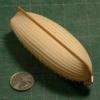-
Posts
13,131 -
Joined
-
Last visited
Content Type
Profiles
Forums
Gallery
Events
Everything posted by druxey
-
Sorry to read of your collision with Atalanta. I hope that you were personally undamaged. The model seems to have recovered well!
- 1,449 replies
-

Echo by tlevine - FINISHED - Cross-Section
druxey replied to tlevine's topic in - Build logs for subjects built 1751 - 1800
The mast step there? Why so it is! Looking good, Toni.- 52 replies
-
Certainly Halinski looks like a class act. Thanks for the free lessons in card model construction, Dan!
-
No so much a band or two, as a collection of whole orchestras! I had no idea that there was so much hardware attached to a wooden main yard during that era. Beautiful work as ever, Ed.
- 3,618 replies
-
- young america
- clipper
-
(and 1 more)
Tagged with:
-
Starting to look ship-shape, Maury! She's looking good.
- 525 replies
-
- anchor hoy
- hoy
-
(and 1 more)
Tagged with:
-
Thanks for this important news bulletin, Sam. Lots of smiles here - and I needed them today. Thank you.
-
Geez. A lot of cannon shot passed through those frames. It must have been a very hot action! Your battery of cannon returned fire, I hope. They look good.
-
Before you go too far down this road, remember that the figure cannot project too far forward and is constrained by the bowsprit above and the lower cheek termination aft (red lines, approximate). Everything would be far more compacted, with minimal projections, such as wings or fully extended arms, to catch and be broken off.
-

HMS VICTORY 1759 by isalbert
druxey replied to isalbert's topic in - Build logs for subjects built 1751 - 1800
Incroyable! Very nicely done, isalbert. -
Thanks for my smile today! There is a saying, "Many hands make light work", but in this case it is more like "Many hands make dark work"!
About us
Modelshipworld - Advancing Ship Modeling through Research
SSL Secured
Your security is important for us so this Website is SSL-Secured
NRG Mailing Address
Nautical Research Guild
237 South Lincoln Street
Westmont IL, 60559-1917
Model Ship World ® and the MSW logo are Registered Trademarks, and belong to the Nautical Research Guild (United States Patent and Trademark Office: No. 6,929,264 & No. 6,929,274, registered Dec. 20, 2022)
Helpful Links
About the NRG
If you enjoy building ship models that are historically accurate as well as beautiful, then The Nautical Research Guild (NRG) is just right for you.
The Guild is a non-profit educational organization whose mission is to “Advance Ship Modeling Through Research”. We provide support to our members in their efforts to raise the quality of their model ships.
The Nautical Research Guild has published our world-renowned quarterly magazine, The Nautical Research Journal, since 1955. The pages of the Journal are full of articles by accomplished ship modelers who show you how they create those exquisite details on their models, and by maritime historians who show you the correct details to build. The Journal is available in both print and digital editions. Go to the NRG web site (www.thenrg.org) to download a complimentary digital copy of the Journal. The NRG also publishes plan sets, books and compilations of back issues of the Journal and the former Ships in Scale and Model Ship Builder magazines.



